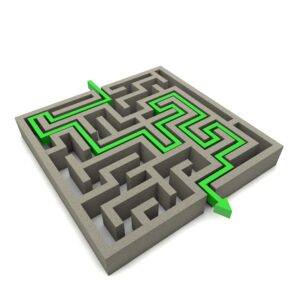Evaluating Primitive Reflexes
Some definitions and processes to be aware of:
Primitive Reflexes can be in any one of 5 states:
- absent
- active and dominant
- enmeshed
- partially integrated
- integrated
That means that the movement response to a specific sensory stimulus is any of the following:
- not there, perhaps not possible
- the only response
- linked to another unexpected movement
- one of some choices of response but under stress reverts to the only response or the enmeshed version
- one of many choices of response and there is freedom to change the response
Some of the stimuli and their responses are not comfortable to experience, so it is ill advised to just randomly apply the reflex stimulus, looking for the response.
In some people, the repeated non-therapeutic experience of the reflex stimulus has a cumulative traumatic effect
and can result in neurological shut down.
Inappropriate Primitive Reflex Activity, (active beyond the developmental age when it should have evolved into a choice) though relatively easily remedied, needs to be correctly evaluated so that one is creating the brain pathways in the correct places. This is because Hebb's axiom is true - that "What Fires Together Wires Together". It is essential for functional improvement that the correct pathways fire together - so that the correct pathways are wired together.
 This is not a hit and miss thing. There is a system to the development of humans and our complexity. When you have an evaluation done, make sure the person has the credentials to do so.
This is not a hit and miss thing. There is a system to the development of humans and our complexity. When you have an evaluation done, make sure the person has the credentials to do so.
At KidsBrainTree Fort Collins, a Primitive Reflex Evaluation is part of a Neurological Maturity Evaluation. The presence of active or enmeshed reflexes, as well as the extent to which reflex patterns are absent or integrated is done together with a determination of the person's neurological patterns under stress, the amount of perceived safety within their body, their basic connectedness to themselves and others, and their cognitive development in terms of the consolidation of their ability to categorize.
The KBT (FoCo) Neural Maturity Evaluation Process:
There are parts that are hands-on, parts that include an interview, some forms and questionnaires and a part where we check for parasites and latent strep and then the feed back. The bit where we evaluate actual movement takes 55 minutes in the clinic, is part of the $450 cost and is best booked after we have had a chance to meet for the discovery visit.
The first meeting is the free 20 minutes, is free and the time you decide if you like our approach.
The second is at the intake because 99% of the time there is back story that plays into the game. The intake helps me to know the complexity of what is going on. It also gives us a chance to decide together if Primitive Reflexes are the only area inhibiting maturity and the development of choice. It is possible that there are components of auditory processing and visual motor /perceptual processes that are playing into what is worrying you. It is also best if I have at least a fair understanding of any traumatic past instances, what you have investigated and tried, and how bad the situation is. It is at this time that we like to collect the lock of hair, some fingernail clipping and a saliva swab. If you want to do this at home and bring it in or mail it, that is perfectly okay. This allows us to check for parasite and latent strep. It also allows us to look at Vagus nerve function.
The movement piece of the evaluation is easiest done in the clinic. However we also work online -and this looks a bit different over zoom. If that is what you need, we can discuss it. The process is slower because we have to teach you step by step how to ask for the specific movements we need to see to complete the eval. That part takes abit of time.
The last meeting is the feed back time. It is 1 hour and is very comprehensive. You can expect to get answers in many realms. Sometimes you will need to deal with parasites, sometimes strep, often times family relating, and then the actual movement and perceptual function of your child. We will set out a plan for the next steps and check-ins.
Specific reflexes that we evaluate:
- Fear Paralysis Reflex
- Moro / Startle Reflex
- Tonic Labyrinthine Reflex (TLR)
- Hands Pulling and Grasp Reflexes
- Babkin Reflex
- Symmetrical Tonic Neck Reflex (STNR)
- Tendon Guard Reflex
- Landau
- Babinski and Grasp Reflex
- Amphibian
- Spinal Galant
- Bauer Crawling
- Asymmetrical Tonic Neck Reflex (ATNR)
If needed - the following will also be evaluated
- Rooting
- Eye movement - tracking, accommodation, focus
- Finger movement which looks at hand and fine motor development.
- Cranial Movement - how the bones in the head are moving

What we do with the Results:
With the evaluation information, we can make a decision about what to do next. If inappropriately active Primitive Reflexes are interfering with behaviour and academic achievement, we will sit down and talk about your options for intervening. If we decided in the intake that we need to do further evaluations - such as auditory processing evaluations, or other visual-motor-integration or perceptual evaluations, we will schedule and do those to get the fullest picture possible. This will help you make the best most appropriate choice for growing the brain connections needed to resolve the issues you wish to resolve.
Most interventions in our clinic involve a series of movements to do at home for up to 15 minutes a day, and weekly or bi-weekly treatment times at the office for short bursts of time. Children usually manage 16 sessions and then need break.
We have found the following to be absolutely true of these kinds of movement interventions –
If the movements are not done the brain growth does NOT happen.
We also have interventions for the parasites. Unfortunately they can be a bit challenging but you just do them. We have been addressing the strep through RIFE technology quite successfully. We will explain this more at the time.
Consider the following:
These are factors that seem to play into not doing the movements that grow the brain regularly, at home. You will need to consider if these factors will have any impact when working with us.
- A fever (101F +) will set a child back 2 weeks each time.
- Intermittent attendance will double the time needed to move along the time line.
- The exercises don’t seem to be near the top of the priority list for the adults. There is a “well we just didn’t get to it” way of approaching the Home Program
- There is a power struggle between the child and parent, and as a result the parent has very little leverage in what the child does
- Parents think that the child should take responsibility for doing the exercises. (PS:- if they could do them on their own they would not be having the other problems)
- Dad undermines Mom’s program or plan
- School is too exhausting and homework too much to leave time for the program
- Too little time between family getting home from jobs & sports and bed time.
We know these factors well and want to help counter these potential causes of the interventions not working at the speed we promise (within 32 sessions) - so....
- We have this discussion – to emphasis that the home program is CRUCIAL to the overal progress.
- We give you a check off sheet to record the sessions and we can have a prize for honest completion (we will know). Some people work for chocolate.
- We check in each session to see if you have hit any road blocks – At times it may be technique or it may be incentive. It may be time to upgrade the activity. We will problem solve together.
- We teach parents separately to children – so that you can experience the Home Program yourself and ask any questions.
- We offer to teach a tutor or support staff who will carry out the program.
- We have an online video class that has videos that reviews what we teach you .. through teachable.com.
- We offer to do the exercises 3x a week with your child for 15 min. 3x plus the weekly session give us 4/7 days which is the absolute minimum if you want to see change. The cost is $35 for each 15 minutes.
- We tackle the parenting piece – looking at why the struggle, and if this is a really big part, there may be other issues at play. We invite parents to take the opportunity to sort through their own traumas and learned relating patterns to find new ways to connect that do not engage the power struggle, yet at the same time are not dismissive of the child’s need to connect. (This means NO extinction strategies nor operant conditioning. We want you to have a relationship, not a servitude)
- We limit the period we intervene to 16 sessions with the kids at a time (after evals etc) so that there is at the least a break from or possible an end to the intervention (it is not forever) and encourage parents to mark the end eval date on the calendar.
- We have an expected timeline of when certain movements should be mastered. If you are not on schedule – we will raise the questions needed. At times this may mean that the progress was slowed enough for us suggest a 2nd or 3rd series of 16. We do not mind this and sometimes that is just the way it is. To reach the goal, this is the path we must follow.